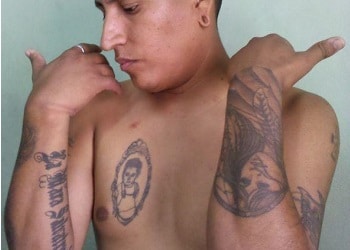The capture of the head of Peru’s own “Mara Salvatrucha” is likely an example of Central America’s MS13 inspiring similar — but probably unconnected — criminal operations far from home.
Peruvian authorities have arrested a man described as the head of the “Mara Salvatrucha Peru” or “MSX3,” an acronym apparently also used to denote the MS13, La República reported.
Police arrested Balbín Antonio Castillo Nole during a routine search in a Lima district on August 2, El Comercio reported. The subject is reportedly wanted for drug trafficking, kidnapping, extortion, attempted homicide, and theft.
SEE ALSO: Coverage of Criminal Migration
Castillo had been on the run since 2012, when he was arrested in his home town, the port city of Callao, under similar accusations. It is not known how, if or why he was released, according to local media.
Past press reports suggest that the MSX3’s activities focused on collecting extortion, dealing drugs in their neighborhoods and running contract hitman networks. Members also brandish tattoos similar to those used by Central American gangs.
InSight Crime Analysis
While such news does inspire headlines, the presence of MS13 branches as far south as Peru is far from a given. As InSight Crime has noted in the past, the ability of the MS13 — whose strongest base is in the Northern Triangle countries of El Salvador, Honduras and Guatemala — to expand transnationally is, for now, weak. Even proof of coordination between the gangs based in these neighboring countries has been limited.
While there are definite parallels between Peru’s own Mara offshoot and the MS13, it is unlikely that they work together. Indeed, Peruvian authorities have described local Mara factions as “inspired” by, or “imitators” of, Central America’s gangs.
SEE ALSO: MS13 News and Profile
Claims of Mara spinoffs have been made even further south, in Argentina. Last year, authorities arrested Richard Castillo Salazar — originally from the same Peruvian town as Castillo — in Buenos Aires. Salazar claimed to be the “the head of the Mara Salvatrucha.”
In other cases, the arrests of Central American MS13 members abroad has sparked concerns of expansion, although there has been little evidence that their foreign presence was more than incidental.
If anything, the emergence of criminal groups using the Mara brand name across the continent — even as far as Europe — speaks to the looser nature of today’s organized criminal groups and the increasing fragmentation of the traditional crime cartels.
Some of Latin America’s most powerful syndicates, such as Mexico’s Sinaloa Cartel and Colombia’s Urabeños, have evolved into franchise-style organizations. These franchises give their name to a plethora of smaller groups who use the brand to incite fear and operate, while being only loosely affiliated to the organization’s leadership, if at all.
A trend of bottom-up rather than top-down growth has also emerged, with street gangs gradually becoming more sophisticated and powerful as old school criminal structures weaken.

